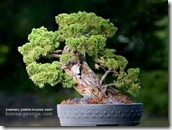 Overview
Overview
Bonsai trees are regular sized trees that are pruned to grow in miniatures sizes. These trees can be raised indoors and outdoors, and require regular attention and care. The bonsai is a form of art and its care should be enjoyable and relaxing.
Step 1
Place your bonsai tree in an area that receives at least five hours of direct sunlight each day, whether they are indoors or outside. Bonsais are sun loving trees that require direct sunlight to thrive. Still, indoor bonsais will also benefit from the warm of the sun when they are placed on the deck or patio.
Step 2
Plant your bonsai trees in sandy loam that includes nutrient rich soil and a good drainage system. Create a sandy loam by using two parts soil and one part sand. Fertilize your bonsai monthly, during its growing season. Use a well balanced fertilizer that includes phosphorous, potassium and nitrogen and incorporate the fertilizer into the soil at half strength. Avoid placing the fertilizer directly onto the roots of the tree, as this may cause root burn.
Step 3
Water your bonsai regularly. Bonsai trees are avid feeders that require plenty of moisture. It is important that the bonsai is not overwatered, however. Check your bonsai’s soil moisture daily. Only water the tree when the soil feels dry. The container’s drainage system should allow excess water to exit the container.
Step 4
Dust your bonsai’s foliage regularly to remove dust mites and airborne bacteria. This settlement can promote bonsai disease. Spray the bonsai’s foliage with a water mist throughout the day to promote its health and green color. Bonsais require humidity and moisture in the air. Indoor bonsais will benefit from the mist, as indoor air is usually very dry. Outdoor bonsais benefit from misting during the dry summer periods.
Step 5
Inspect your indoor bonsai regularly for mites and insects. Bonsai trees are ideal havens for spider mites. If you find yellow spotting on foliage or small webs throughout the tree, your bonsai has become infested. Treat the infestation with a non-toxic insect spray. Speak with your local nursery or horticulturalist for selection assistance.
Step 6
Prune your bonsai tree regularly, and a little at a time. Bonsai trees require pruning of the foliage, stems, branches and root system to maintain a small size. Prune its new growth to promote vigorous growth. Avoid pruning all of the new growth simultaneously to avoid stunting the tree’s growth and overall damage of the tree. Root pruning should be completed while repotting the tree and when the tree shows signs of distress and declining growth.
Step 7
Repot your bonsai tree once every one to two years. Newly planted bonsais should never be repotted during their first year, unless the root system requires it. Ideally, the bonsai tree should be replanted during the early spring, just before its growing season. Repot the tree as quickly as possible. The bonsai’s root system is quite fragile and will dry out very quickly.

Deprecated: strpos(): Passing null to parameter #1 ($haystack) of type string is deprecated in /home/agriviek8Qv/agriviet.net/public_html/wp-includes/comment-template.php on line 2522